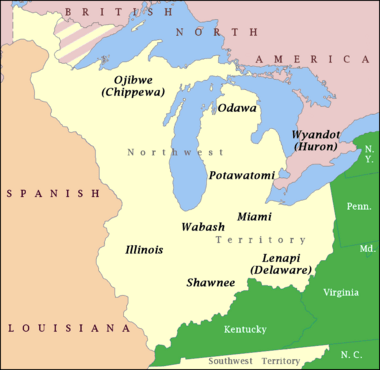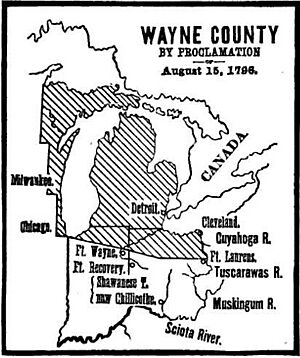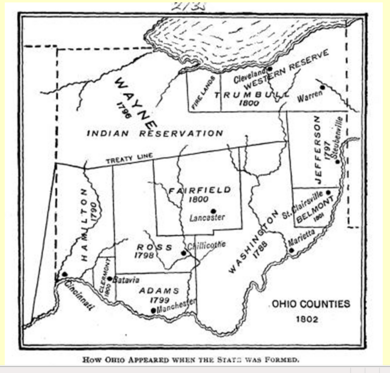Northwest Territory facts for kids
Quick facts for kids Territory Northwest of the River Ohio |
|||||||||||||
|---|---|---|---|---|---|---|---|---|---|---|---|---|---|
| Organized incorporated territory of United States | |||||||||||||
| 1787–1803 | |||||||||||||
|
|
|||||||||||||
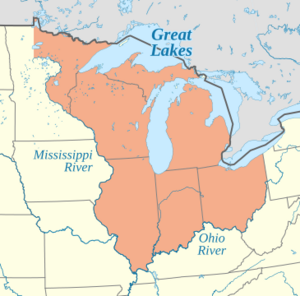 Territory Northwest of the River Ohio, 1787 |
|||||||||||||
| Capital | Marietta (1788–1799) Chillicothe (1799–1803) |
||||||||||||
| Area | |||||||||||||
| • Coordinates | 41°N 86°W / 41°N 86°W | ||||||||||||
| Government | |||||||||||||
| • Type | Organized incorporated territory | ||||||||||||
| • Motto | Meliorem lapsa locavit "He has planted one better than the one fallen" |
||||||||||||
| Governor | |||||||||||||
|
• 1787–1802
|
Arthur St. Clair | ||||||||||||
|
• 1802–1803
|
Charles Willing Byrd | ||||||||||||
| History | |||||||||||||
|
• Northwest Ordinance
|
13 July 1787 | ||||||||||||
|
• Affirmed by United States Congress
|
August 7, 1789 | ||||||||||||
|
• Indiana Territory created
|
May 7, 1800 | ||||||||||||
| 1 March 1803 | |||||||||||||
|
|||||||||||||
The Northwest Territory, also called the Old Northwest, was a large area of land in the United States. It was created after the American Revolution in 1787. This territory was the first organized land area in the U.S. that was not one of the original thirteen colonies.
It included land west of Pennsylvania, northwest of the Ohio River, and east of the Mississippi River. This area later became all or parts of six U.S. states: Ohio, Indiana, Illinois, Michigan, Wisconsin, and northeastern Minnesota.
Before the American Revolution, this land was part of the British Province of Quebec. The U.S. gained control of it in the Treaty of Paris of 1783. The Northwest Territory existed until March 1, 1803, when Ohio became a state. The rest of the land was added to the Indiana Territory.
When it was first created, the territory had very few towns. It was home to many Native American groups, like the Delaware, Miami, Potawatomi, and Shawnee. As more settlers moved in, conflicts arose. These led to the Northwest Indian War, which ended in 1794.
Contents
Where was the Northwest Territory?
The Northwest Territory covered a huge area. It included all the land the United States owned west of Pennsylvania, east of the Mississippi River, and northwest of the Ohio River. This means it covered all of modern-day Ohio, Indiana, Illinois, Michigan, and Wisconsin. It also included the northeastern part of Minnesota.
To give you an idea of its size, it was more than 300,000 square miles. This was about one-third of the entire United States at the time!
About 45,000 Native Americans lived in this region. There were also about 4,000 non-Native traders, mostly French, British, or Irish. Some of the tribes living there were the Shawnee, Delaware, Miami, Wyandot, Ottawa, and Potawatomi.
History of the Territory
For the Northwest Territory to become part of the U.S. and be settled, a few things had to happen. First, the British had to leave. Second, the states that claimed parts of this land had to give up their claims. Third, the U.S. had to gain control of the land from the Native Americans, either by treaties or by force.
Early European Exploration
European explorers, mostly French-Canadian fur traders and missionaries, first explored this region in the 1600s. Jean Nicolet was one of the first Europeans to explore the area in 1634. The French claimed this land as part of New France. They built forts, like Fort Detroit, founded in 1701.
After losing the French and Indian War, France gave this territory to Great Britain in 1763.
British Rule and the American Revolution
From the 1750s, Britain wanted to create a large Native American state in this area. This "Indian barrier state" would block American expansion and help Britain control the fur trade.
In 1763, Britain issued the Proclamation of 1763. This rule stopped white settlers from moving west of the Appalachian Mountains. This made many American colonists angry. In 1774, Britain added the region to the Province of Quebec. This was to help manage the fur trade.
During the American Revolutionary War, George Rogers Clark led American forces to capture key British forts in the area. Virginia then claimed the entire region. After the war, Britain officially gave the land to the United States in the Treaty of Paris (1783). However, the British still had some presence in the region until 1815.
States Give Up Their Land Claims
Several states, including Virginia, Massachusetts, New York, and Connecticut, had their own claims to parts of the Northwest Territory. These claims often overlapped.
To create a stronger United States, these states agreed to give up their claims to the federal government. New York did so in 1780, Virginia in 1784, and Massachusetts and Connecticut in 1785. This meant most of the territory became public land owned by the U.S. government.
The U.S. government then created laws to organize this land. The Land Ordinance of 1784 planned how the territory could be divided into new states. The Land Ordinance of 1785 set up a system to survey the land into square plots for sale. This made it easier for people to buy and settle the land.
Founding the Government
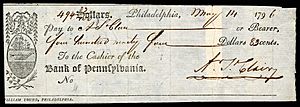
The Northwest Ordinance of 1787 officially created the Northwest Territory. Arthur St. Clair was appointed as its first governor. He set up the government on July 15, 1788, in Marietta. Later, he moved the main government center to Cincinnati.
Governor St. Clair helped create the first laws for the territory. These laws were based on English common law. They helped protect residents and set up a court system.
Northwest Indian War
The U.S. government needed money after the Revolutionary War. They planned to sell land in the Northwest Territory. This meant moving Native American villages and settlers who had already claimed land. Native American tribes, supported by the British, resisted these changes.
Native American groups formed a group called the Western Confederacy. They wanted the Ohio River to be the boundary between their lands and the American settlers' lands.
Governor St. Clair tried to make treaties to gain Native American land. However, many Native American leaders did not agree to these treaties. This led to the "Northwest Indian War." In 1790, American forces were defeated by Native Americans.
In 1791, a group of settlers were attacked in what became known as the Big Bottom massacre. Later that year, Governor St. Clair led a large army against the Native Americans. On November 4, 1791, his army suffered a huge defeat. This event, known as "St. Clair's Defeat," was the biggest loss for a U.S. army against Native Americans in history.
After this defeat, President George Washington appointed Major General "Mad" Anthony Wayne to lead a new army. Wayne trained his soldiers carefully. In 1794, Wayne's army defeated the Native American confederacy at the Battle of Fallen Timbers. This victory helped the U.S. gain more control over the territory.
The Treaty of Greenville in 1795 brought peace to the region. It opened up much of southern and eastern Ohio for American settlement.
Settling the Land

After the Revolutionary War, many people wanted to move west. Roads and trails were built to help settlers reach the new lands. The U.S. government sold land to settlers and land companies. They also gave land to military veterans.
The first settlements often grew near forts. Rufus Putnam, known as the "Father of Ohio," helped create the Northwest Ordinance. He also led the first group of veterans to settle in Marietta, Ohio. They built a fort there called Campus Martius.
Putnam and others made sure the Northwest Territory would be a free territory, meaning no slavery was allowed. This was a very important decision. It doubled the size of the United States and made sure that new states formed from this land would not have slavery.
Putnam also helped establish education in the territory. Land was set aside for schools. The first public university in the Northwest Territory, Jefferson Academy (now Vincennes University), was founded in 1801. Ohio University was founded in 1804.
By 1800, the Northwest Territory had a population of over 45,000 people. Many towns grew, especially along the Ohio and Miami Rivers.
Ohio Becomes a State
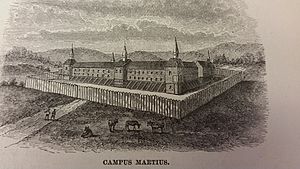
In 1800, Congress divided the Northwest Territory into two parts. The western part became the Indiana Territory. The eastern part, which included most of present-day Ohio, remained the Northwest Territory.
Governor St. Clair did not want Ohio to become a state too quickly. However, President Thomas Jefferson removed him from office in 1802. On March 1, 1803, Ohio officially became the 17th state in the United States. When Ohio became a state, the Northwest Territory no longer existed. Any remaining land was added to the Indiana Territory.
The Northwest Ordinance
The Northwest Ordinance of 1787 was a very important law. It set up the rules for how the Northwest Territory would be governed. It also laid out how new states could be formed from the territory.
Land Ownership
The Ordinance established the idea of "fee simple" ownership. This meant that people who owned land had full and permanent control over it. They could sell it or give it away as they wished.
No Slavery Allowed
A key part of the Northwest Ordinance was that it banned slavery in the territory. This was the first time the U.S. government had prohibited slavery in a new territory. This decision was supported by many leaders, including Thomas Jefferson. They hoped that slavery would eventually disappear as the country grew.
Native American Lands
The Ordinance also addressed Native American lands. For example, 10,000 acres of land were set aside for the Moravian Brethren. This group worked to help Native Americans and promote Christianity.
Importance of Education
The Northwest Ordinance strongly supported education. Article 3 stated that "Religion, morality, and knowledge being necessary to good government and the happiness of mankind, schools and the means of education shall forever be encouraged."
The Land Ordinance of 1785 also helped public education. It set aside one specific plot of land in every township for the support of public schools. This helped ensure that schools would be built and funded in the new settlements.
Settlements and Forts
Many forts and settlements were built in the Northwest Territory between 1778 and 1803. Most forts were military bases. Early settlements often grew near these forts. After the Treaty of Greenville, new towns could grow without needing a fort nearby.
Here are some of the important places established:
- Fort Laurens (Ohio), 1778
- Cahokia, Illinois, 1778
- Fort Gage, Kaskaskia, Illinois, 1779
- Fort Patrick Henry, Vincennes, Indiana 1779
- Clarksville, Indiana, 1783
- Fort Harmar, Ohio, 1785
- Fort Steuben, Ohio, 1787
- Marietta, Ohio, 1788
- Cincinnati, Ohio, 1788
- North Bend, Ohio, 1789
- Fort Washington, Ohio, 1789
- Massie's Station, 1790
- Gallipolis, Ohio, 1790
- Fort Hamilton, Ohio, 1791
- Fort Jefferson, Ohio, 1791
- Fort St. Clair, Ohio, 1792
- Fort Greene Ville, Ohio, 1793
- Fort Recovery, Ohio, 1793
- Fort Massac, Illinois, 1794
- Fort Defiance, Ohio, 1794
- Fort Wayne, Indiana, 1794
- Fort Loramie, Ohio, 1794–95
- Chillicothe, Ohio, 1796
- Cleveland, Ohio, 1796
- Fort Miami, Ohio (British held until 1796)
- Fort Lernoult (previously Fort Detroit), Michigan (British held until 1796)
- Fort Mackinac, Michigan (British held until 1796)
- Williamsburg, Ohio, 1796
- Dayton, Ohio, 1796
- St. Clairsville, Ohio, 1796
- Athens, Ohio, 1797
- Franklinton, Ohio, 1797
- Mentor, Ohio, 1797
- Warren, Ohio, 1798
- Bethel, Ohio, 1798
- Zanesville, Ohio, 1799
- Greenfield, Ohio, 1799
- Lancaster, Ohio, 1800
- Springfield, Ohio, 1801
- Youngstown, Ohio, 1802
- Coshocton, Ohio, 1802
- Lawrenceburg, Indiana, 1802
- Lisbon, Ohio, 1803
- Xenia, Ohio, 1803
Counties of the Territory
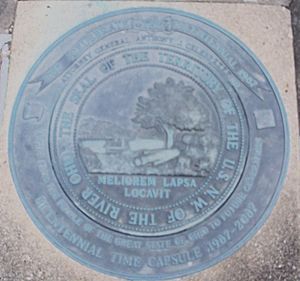
Governor Arthur St. Clair created thirteen counties during the Northwest Territory's existence:
- Washington County (1788), seat at Marietta.
- Hamilton County (1790), seat at Cincinnati.
- St. Clair County (1790), seat at Kaskaskia.
- Knox County (1790), seat at Vincennes.
- Randolph County (1795), seat at Kaskaskia.
- Wayne County (1796), seat at Detroit.
- Adams County (1797), seat at Manchester.
- Jefferson County (1797), seat at Steubenville.
- Ross County (1798), seat at Chillicothe.
- Trumbull County (1800), seat at Warren.
- Clermont County (1800), seat at Williamsburg.
- Fairfield County (1800), seat at Lancaster.
- Belmont County (1801), seat at St. Clairsville.
When Ohio became a state in 1803, the Northwest Territory ended. The remaining land was added to the Indiana Territory.
Images for kids
See also
 In Spanish: Territorio del Noroeste para niños
In Spanish: Territorio del Noroeste para niños




